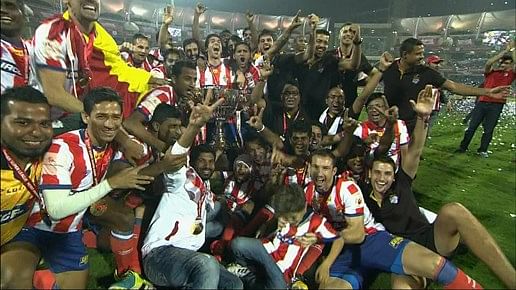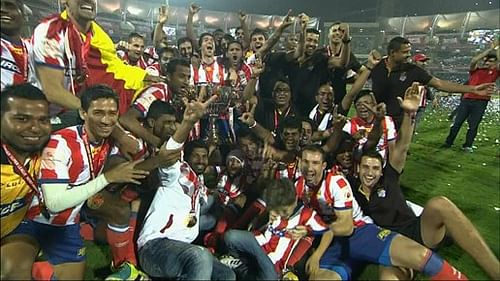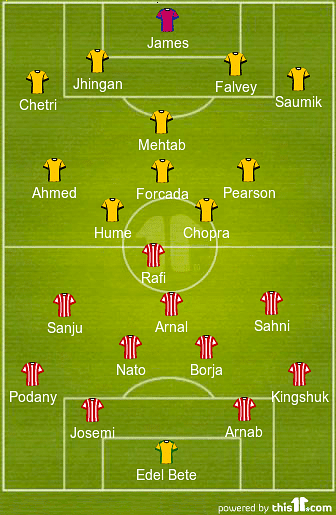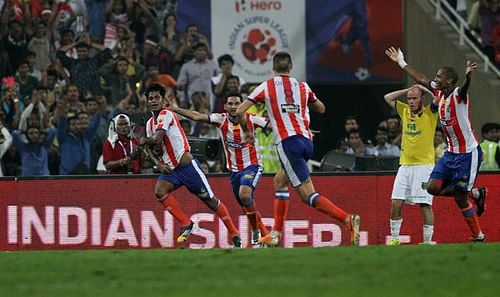
ISL: Kerala Blasters vs Atletico de Kolkata - Tactical Analysis

The first champion has been anointed in the Indian Super League after over two months of football action and it was Atletico de Kolkata who walked away with the grand prize after beating Kerala Blasters in yesterday’s final in Mumbai. The game itself stayed true to expectation as a grind-fest as has been customary in games involving Kolkata this season. In the end, Kolkata’s late rally sealed the deal for them. Here we attempt to look at how the game went from a tactical point of view.
Line-Ups
Kerala adopted the same shape as they’d done for the second leg of their semi-final against Chennaiyin FC going 4-1-3-2 with Mehtab Hossain in the deep-lying midfield role. Iain Hume and Michael Chopra started up front in keeping with the trend with the most notable change in the side being captain and player/coach David James returning between the posts in place of Sandip Nandy. Kerala had gone with a 4-4-2 in the first leg of the semi-final which they won 3-0, but owing to the stage of the competition decidedly went the cautious route.

Atletico too showed few surprises going in with the tried and test 4-2-3-1 with Ofentse Nato and Borja Fernandez sitting in front of the front four. The duo had been excellent in the lead up to the final having played a key role in their run to the final by protecting the back four and making it tough for opponents to break them down. No Fikru Teferra for the final meant a place for Mohammad Rafi as the lone striker up front. Captain and marquee player Luis Garcia had to contend with a place on the bench.
Tactics
Kerala generally over the course of the tournament have been a team that don’t necessarily go full throttle on attack. Perhaps the lone exception to that came in their home leg of the semi-finals. Chennai almost pulled off a miraculous comeback, but guess James went in with the same formation knowing that he was going up a defensive-minded team against Kolkata and that his team would probably be doing more of the attacking. The two forwards were testament to that as James perhaps hoped to get a goal, maybe two through the industry of Hume and Stephen Pearson and use the presence of Mehtab to defend effectively.
Kolkata coach Antonio Habas has been one of the most tactical coaches in the ISL and he opted to go with a 3-5-2 in the second leg of his team’s semi-final against FC Goa. The move did not work that well as they came under pressure from Goa which forced him to tweak the line-up and the outfit that he arrived at is what he retained for the final. He chose to utilitze winger Jakub Podany as a traditional left-back in the back-four with Kingshuk Debnath on the right. A big part of Atletico’s plan, not for the first time, was safety first and make sure that they defend their goal. Borja (who led the league in tackles made) and Nato have been brilliant in ensuring that and that was likely why Garcia too was held back to bring on against tired legs.
Final Play
Kerala started the better after a high-tempo opening from both sides. Kolkata were more than happy to sit back and soak up the pressure and though Kolkata ended up having more possession (51% to 49%), it was Kerala who did much of the attacking. They had more shots and also earned more corners through possession.
Pearson and Hume were the key channels through which Kerala attacked and Apoua Edel Bete was busy once again in goal for Habas’ team. Chopra playing with Hume also enabled Kerala to test that Kolkata defence a bit more and it was those two who had the best chances of the match.

Hume’s shot was tipped wide in the 37th minute and Chopra in the second half had a great chance, but he once again found Edel Bete in the way. Kerala dominated for much of the second half too and were the more aggressive.
Borja was given the responsibility of controlling the tempo for Kolkata, as he led the odd foray out every now and then, but for the most part they were willing to buckle in and defend. And they looked comfortable barring the odd chance created by Kerala. Kolkata were content to slow down the pace and rely on set pieces to try and mount some sustained attack.
Verdict
Overall, the game was a tight, cagey affair as could have been expected from two teams who grinded their way through the campaign and were not exactly teams high on flair. Kerala did most of the running with the ball and created a few good openings, but did not have the beating of the keeper.
Kolkata did what they do best in soaking up the pressure and were comfortable to hold their line and maintain good defensive shape, looking to hit on the counter. And the sucker punch came, cruelly late for Kerala, but that’s football and the tactical plan of Habas to contain and nick it in the end paid off once again.